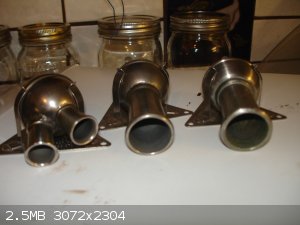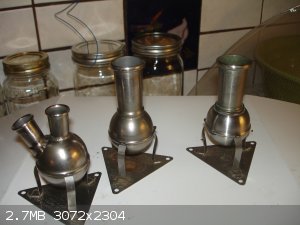SWIM
National Hazard
   
Posts: 970
Registered: 3-9-2017
Member Is Offline
|
|
Steel RBFs
I've picked up these round bottom flasks which seem to be stainless steel.
They're certainly some rustproof gray metal, but they have no markings whatsoever except an 'M' on each one.
Two have standard taper joints in 24/40, and one is a 2-neck 14/20 flask.
Two were assembled by welding, and one looks like it might have been brazed together.
So just what are these things actually for?
High temps and caustics?
If I stick a glass fitting in one of those standard taper steel outer joints, won't the different expansion coefficients be a problem?
Will I have to hunt up steel condensers and dropping funnels to use this stuff? Or some hellishly expensive glass-to-metal fittings?
Okay, so I bought something I know nothing about..again, but I'd never even seen a steel RBF in regular lab-scale size before, and these little
beauties were just as cute as lace pants.
Anyway, any information would be appreciated.
The only similar stuff I've seen is large Ace-style reaction kettles; and they had flat flanges, not tapered steel joints.
|
|
|
draculic acid69
International Hazard
    
Posts: 1371
Registered: 2-8-2018
Member Is Offline
|
|
Can you post pictures ?
|
|
|
BromicAcid
International Hazard
    
Posts: 3253
Registered: 13-7-2003
Location: Wisconsin
Member Is Offline
Mood: Rock n' Roll
|
|
I've seen steel flasks used in the past for distillation / preparation of pyrophoric materials to help mitigate the risk of breakage.
|
|
|
SWIM
National Hazard
   
Posts: 970
Registered: 3-9-2017
Member Is Offline
|
|
 

These are them.
They're black on the inside. Don't know if they're ashed in a furnace to clean them or if they're just dirty.
(It just occurred to me that it will be challenging to tell when these things are clean too)
[Edited on 5-1-2019 by SWIM]
|
|
|
Assured Fish
Hazard to Others
  
Posts: 319
Registered: 31-8-2015
Location: Noo Z Land
Member Is Offline
Mood: Misanthropic
|
|
Oh wow, ive thought about those before but ive never seen them anywhere.
They could be one of a kind.
If you wanted to put them to use i think you may get away with glass joints that are perhaps slightly smaller than the joints on the flask, which are
then packed with ptfe tape to seal them, i suppose if the temp was below 200*C i doubt there would be enough thermal expansion to put any strain on
the glass but id be more concerned with it not sealing.
You could definitely do some simple organic stuff in them, but there are alot of things that would be just plain incompatible (especially acids).
Maybe making benzene via decarboxylation of benzoic acid or another thermal decarboxylation.
Maybe even prepare anhydrous ammonia.
2 NH4Cl + 2 CaO → CaCl2 + Ca(OH)2 + 2 NH3
This chart may be of some use.
https://www.calpaclab.com/stainless-steel-chemical-compatibi...
Sufficiently advanced science is indistinguishable from madness.
|
|
|
OldNubbins
Hazard to Others
  
Posts: 136
Registered: 2-2-2017
Location: CA
Member Is Offline
Mood: Comfortably Numb
|
|
The bases appear to be stamped "18-8 stainless steel". Is the 'M' on the flask? They could be made of Monel - I have worked with it before, very
difficult to machine/fabricate, VERY expensive - also extremely corrosion resistant to most acids and nasty HF caustics.
If it is Monel, I would expect those to easily cost several hundred bucks apiece to machine and fabricate. Monel is such a pain I would quote them at
$1000 each and be disappointed if I got the job.
|
|
|
draculic acid69
International Hazard
    
Posts: 1371
Registered: 2-8-2018
Member Is Offline
|
|
How much did you get them for?
In my research of high pressure reaction vessels they talked about Monel,inconel and hastelloy all of which are very corrosion resistant.
[Edited on 5-1-2019 by draculic acid69]
[Edited on 5-1-2019 by draculic acid69]
|
|
|
Tsjerk
International Hazard
    
Posts: 3032
Registered: 20-4-2005
Location: Netherlands
Member Is Offline
Mood: Mood
|
|
I would be very careful with placing glass equipment in the necks while heating it, during the heating the glass will slide in further and when it
cools again it will shrink and snap the glass. You could disassemble before cooling but be careful.
|
|
|
GrayGhost-
Hazard to Self
 
Posts: 61
Registered: 31-10-2017
Location: Argentina
Member Is Offline
Mood: No Mood
|
|
I am ironsmith in my current job, I build my own vessels of iron sheet, for distillation and produce ammonia between other reactions. I not have
stainless steel welder ,type ( TIG). The problem is the rust.
|
|
|
SWIM
National Hazard
   
Posts: 970
Registered: 3-9-2017
Member Is Offline
|
|
Quote: Originally posted by OldNubbins  | The bases appear to be stamped "18-8 stainless steel". Is the 'M' on the flask? They could be made of Monel - I have worked with it before, very
difficult to machine/fabricate, VERY expensive - also extremely corrosion resistant to most acids and nasty HF caustics.
If it is Monel, I would expect those to easily cost several hundred bucks apiece to machine and fabricate. Monel is such a pain I would quote them at
$1000 each and be disappointed if I got the job. |
The "M' mark is on each flask, right below the neck, like it was stamped with a simple metal stamp. I'll try to get a clear picture in the morning,
but there's not much to it.
The holders marked 18-8 stainless are, I think, not really related to the flasks. They look like the holders they use for flasks on shaker trays, and
they're marked Fischer and have a patent number on them. I bet they were just something handy to display the flasks on.
I assumed the flasks were stainless, but they do have an odd color.
I have polished the outsides to get the discoloration off, and the result looks a bit darker than clean stainless steels I'm used to. Almost like a
pewter in color.
Any Ideas on how I can find out if these ARE monel?
The density of monel looks like it's in the range of stainless steel, so I suppose I can't use that. The seams on the welded ones do look like
whatever they're made from isn't much fun to weld.( Like it goes mushy when you try to fuse it.)
One of the flasks did have some green crystalline residue in the neck, which Could have either been corrosion, or just residue from whatever they were
last used for. It reminded me of a nickel salt, maybe chloride, in color.
Somebody else asked what they cost.
I bought the set for $30 plus shipping, but that was sort of a special situation. Guy who sold them thought they were something like replicas or
salesman's samples or some sort of scale models.
So basically I was buying lab equipment at toy prices.
|
|
|
j_sum1
Administrator
       
Posts: 6333
Registered: 4-10-2014
Location: At home
Member Is Offline
Mood: Most of the ducks are in a row
|
|
Well, if you don't mind sanding off a little bit of dust from the surface somewhere, you could test for copper. SS does not contain copper but Monel
does.
I am just tryiung to think of a simple wet chemistry test that would differentiate between Ni ands Cu. Give me a moment...
[Edit]
Not much springs to mind.
Assuming you dissolve a few micrograms of your metal in some acid (I would use nitric), you could try the following tests:
Cu2+ forms a red/brown precipitate with potassium ferrocyanide. I don't think Ni2+ does anything similar. But that might not be a good test --
particularly if Fe and Cr are around.
Cu(OH)2 is a lot less soluble than Ni(OH)2. So if you make your solution alkaline and catch the first precipitate, then test that with concentrated
ammonia -- the Cu tetramine colour will confirm the presence of Cu in your original material. That would be a strong indication of your original
material being monel.
[Edited on 7-1-2019 by j_sum1]
|
|
|
Mr. Rogers
Hazard to Others
  
Posts: 184
Registered: 30-10-2017
Location: Ammonia Avenue
Member Is Offline
Mood: No Mood
|
|
Holy moly those are cool!
I have a 100ml 24/40 RBF that is supposedly made from sapphire. I have no idea but that's how it was sold to me.
[Edited on 7-1-2019 by Mr. Rogers]
|
|
|
OldNubbins
Hazard to Others
  
Posts: 136
Registered: 2-2-2017
Location: CA
Member Is Offline
Mood: Comfortably Numb
|
|
Test for Monel:
Depending on the amount of copper in the alloy, Monel should be somewhat magnetic.
1 drop 1:1 nitric acid and water, observe after 5 minutes
No reaction indicates 400 series SS or 17-4 PH
If bright green, add 1 drop concentrated ammonium hydroxide
Blue color indicates Monel
|
|
|
Morgan
International Hazard
    
Posts: 1705
Registered: 28-12-2010
Member Is Offline
Mood: No Mood
|
|
I had some monel fittings and noticed they were weakly magnetic but if put in the freezer they became appreciably more so using a 1 inch neo magnet
with plastic bottle caps over the magnet to protect against chipping as seen here. Dry ice even better.
https://www.sciencemadness.org/whisper/files.php?pid=333823&...
|
|
|